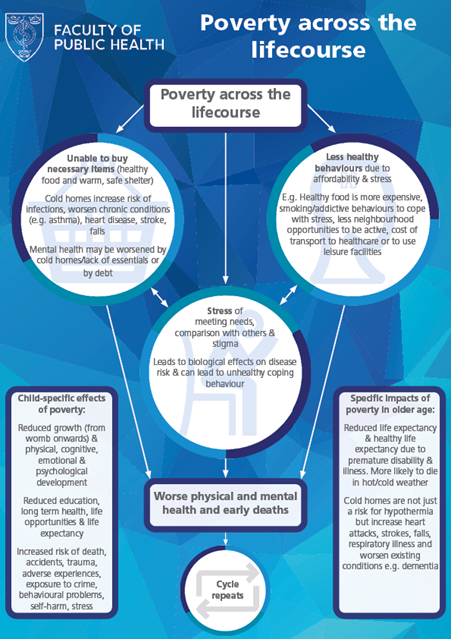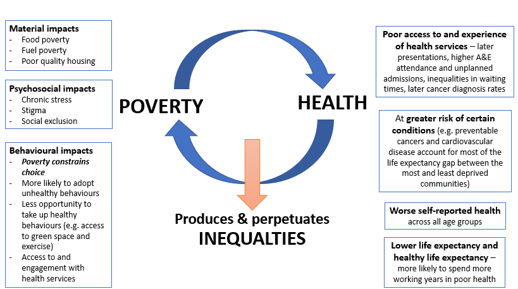Why Poverty Matters to Health
As we face a continuing cost of living crisis exacerbating longstanding high levels of poverty, the impact of poverty on people’s health is creating an increasingly urgent situation. Poverty is a public health problem and requires a public health response, where action is taken across the breadth of the system to both prevent and mitigate the impacts of poverty on health.
What is poverty?
Poverty is usually statistically defined as relative low income: this refers to living in households with income below 60% of the median average for the country. This is the meased used by the government to determine and monitor poverty levels in the UK. The latest data shows that, after taking housing costs into account, 22% of the England population were living in relative poverty. The figure is even higher for children, with nearly 1 in 3 children (31%) living in relative poverty.
The Joseph Rowntree Foundation describes poverty as:
"Not being able to heat your home, pay your rent, or buy the essentials for your children. It means waking up every day facing insecurity, uncertainty, and impossible decisions about money. It means facing marginalisation, and even discrimination, because of your financial circumstances. The constant stress it causes can lead to problems that deprive people of the chance to play a full part in society."
The JRF latest tracker survey (Oct 2023) found that 5.7 million households reported skipping or cutting meals or going hungry. The JRF destitution data showed that in 2022 there were over 3 million people living in destitution including 1 million children.
Why is there so much poverty?
The recent cost of living crisis has brought the scale and impacts of poverty into sharp focus. Millions of people across the country are now struggling to cover essential household costs and some of the basic resources for health. The “cost of living crisis” refers to a situation where inflation has led to the cost of everyday essentials such as food and energy increasing more quickly than average incomes. 2022 saw a 15-16% rise in the price of essential food items, and an 89% increase in the price of enuergy. The Citizens Advice cost of living dashboard shows that in 2022 over 200,000 people were helped with crisis support (food bank referrals and emergency charitable support), a 48% increase on the previous year. Moreover, housing costs have risen especially in the private rental sector at a time when local housing benefits were frozen.
Even before the recognition of the spiralling cost of living crisis since late 2021, poverty (particularly child poverty) was already on the rise. Real wages had not risen since 2010 with the growth of insecure and temporary work, and social security benefits had not risen with inflation and had several restrictions to such as the 2 child limit.. Many individuals and families across the country were already living in or on the edge of financial insecurity. Poverty is a complex, longstanding problem which deeply affects the lives and health of millions every year. The current cost of living situation has only exacerbated an existing crisis.
Poverty is a public health crisis
Poverty and health are inextricably linked. Living with low income impacts a broad range of physical and mental health outcomes, across the life-course and is a key driver of health inequalities.

Living with low income and financial insecurity impacts health through multiple pathways, including:
- Material impacts: Not being able to afford resources for good health such as nutritional food, adequate housing and being able to heat your home, resulting in people living in cold damp homes and going hungry. It is noteworthy that infant and child mortality rates are rising.
- Behavioural impacts: Creates barriers to adopting and maintain healthy behaviours.? Increases risk of addictive behaviours (gambling, alcohol, tobacco)
- Psychosocial impacts: Living with financial insecurity including debt can cause chronic stress and exacerbate existing mental health problems, which increases the risk of poor health and certain diseases. It can also lead to social exclusion.
- Access to health care: Creating barriers to accessing health care, such as not being able to afford to take time off work to attend appointments or not being able to afford to travel to appointments (public transport and car parking charges can both be an issue). Exacerbated by long NHS waiting times?
- Educational: affects childhood cognitive development and impacts on access to and achievement in school
- Social: poverty restricts social participation in leisure/recreational/social events and leads to isolation and loneliness
As we continue to face an escalating cost of living crisis, the impact of poverty on people’s health is creating an increasingly urgent situation. Poverty is a public health problem and requires a public health response, where action is taken across the breadth of the system to both prevent and mitigate the impacts of poverty on health.
It is also important to recognise that the relationship between poverty and health is bidirectional: poverty increases the risk of experiencing poor health outcomes, and someone’s health status can increase their risk of experiencing poverty. For instance, being in poor health may lead to reduced opportunities for paid work and can also result in increased costs such as for resources needed to support health (sometimes termed the “disability premium”). The nature of this bidirectional relationship can create a cycle between poor health and poverty which creates and perpetuates inequalities, as shown in the diagram below.


